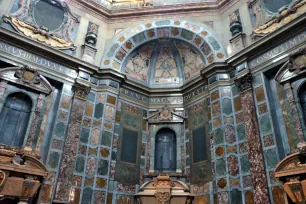The Medici Chapels are two chapels in the Basilica di San Lorenzo (St. Lawrence Basilica) in Florence that were built for members of the powerful Medici family, who long ruled over Florence. Inside are some of the most acclaimed sculpture groups created by Michelangelo Buonarroti.

Even though the chapels were built as part of the Basilica of St. Lawrence, they can now only be accessed from a separate entrance at Piazza Madonna degli Aldobrandini.
The Medici
The Medici reigned over Florence from 1434 to 1743. Giovanni di Bicci (1360-1429), a shrewd banker, laid the groundwork for the family fortune. His son, Cosimo di Giovanni de’ Medici, was the first of the Medici to rule over Florence. The family’s influence spread well beyond the borders of the city. No less than four Medici became popes, and two members of the family became Queen of France. For a long time, the Medici were the wealthiest family in Europe.
The Medici were patrons of the arts and under their reign Renaissance art flourished in Florence. They were also patrons of the St. Lawrence Basilica, their parish church, so they financed the construction of mortuary chapels where the members of the Medici family were to be buried.
Chapel of the Princes



In 1602 Don Giovanni de’ Medici created the first sketches for the Cappella dei Principi (Chapel of the Princes). A competition was held and a design by Matteo Nigetti, based on Giovanni’s sketches, was chosen as the winner. Construction of the chapel officially started on April 6, 1604.
The chapel has an octagonal shape and is covered with a magnificent dome that rises 59 meters (194 ft.) high. Its design was clearly inspired by Brunelleschi’s dome of the Florence cathedral. The dome was only completed in 1743 under the auspices of Anna Maria Luisa de’ Medici, the last scion of the House of Medici. The cupola that crowns the dome was added even later.
The interior is completely covered in marble and semiprecious stones. Originally the idea was to cover the dome in lapis lazuli, but due to the extravagant cost, the dome was instead painted with eight frescoes that depict scenes from the bible.
Against the walls of the chapel are tombs which used to contain the remains of Cosimo III, Francesco I, Cosimo I, Ferdinando I, Cosimo II and Ferdinando II. The tombs are now empty, since all the bodies of the Medici were moved to the crypt below in 1857. Above the tombs are niches. Only two, those of the dukes Ferdinando I and Cosimo II, contain statues. The others were planned but never completed. On the walls between the tombs are sixteen coats-of-arms that represent Tuscan cities that were part of the Duchy of the Medici.



New Sacristy
A corridor leads from the Chapel of the Princes to the Sagrestia Nuova (New Sacristy), the oldest of the two Medici Chapels. Its construction was commissioned in 1520 by Giulio de’ Medici (the future pope Clement VII), who wanted to create a sepulchral chapel for his father Giuliano and his uncle Lorenzo the Magnificent. The latter had adopted Giulio after his father was murdered in 1478 during a failed coup.
The chapel was created in 1521-1524 by Michelangelo, who adorned the tombs with magnificent sculptures, which he worked on until he moved to Rome in 1534. By that time, only two of the four intended marble sculptures were completed. Ironically they adorn the tombs of two lesser-known Medici: the tomb of Giuliano, son of Lorenzo the Magnificent is embellished with allegorical statues of Day and Night, while the statues of Dawn and Dusk grace the tomb of Lorenzo di Piero, grandson of Lorenzo the Magnificent. The sculptures for Lorenzo the Magnificent himself and his brother Giuliano were never completed.
The most famous statue is that of the Night, which shows a nude woman lying on the tomb. Her pose was possibly inspired by the ancient statue of a sleeping Ariadne.
A statue of the Madonna and Child, which was created by Michelangelo as part of the monument intended for Lorenzo the Magnificent, now stands against a wall above an unremarkable tomb created in 1559 for the two brothers. The Madonna is flanked by statues of saints Cosmas and Damianus that were created to Michelangelo’s designs by his students.
Crypts
The remains of almost fifty members of the Medici family are now buried in the vaulted crypt below the Chapel of the Princes. The Museum of the Medici Chapels displays a collection of valuable objects here, including large coins, precious reliquaries, paintings of the Medici and a twentieth-century bronze statue of Anna Maria Luisa de’ Medici created by Alfonso Boninsegni.
In 2004 a staircase was discovered in the new sacristy, below the tomb of Gian Gastone de’ Medici, the last Grand Duke of Tuscany. The staircase led to a hidden crypt which contained the sarcophagus of Gian Gastone and multiple small coffins with the remains of children.

